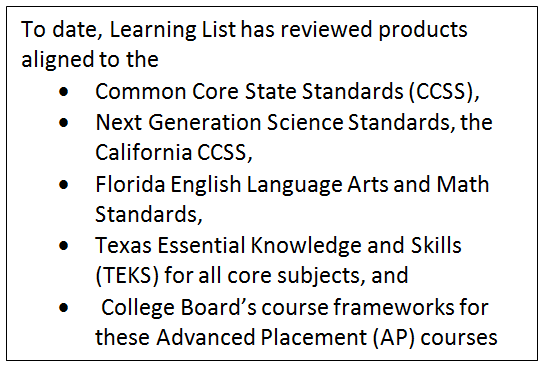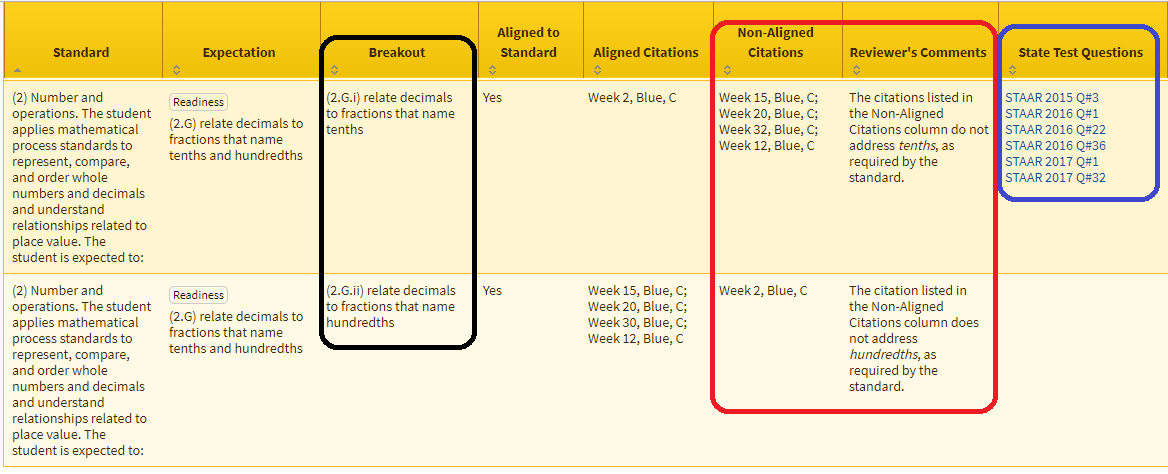This is Part Two of a post in response to the recent report Leadership Perspectives on Public Education: The Gallup 2017 Survey of K-12 School District Superintendents. As discussed in our first post, the superintendents who participated in the Gallup 2017 Survey identified teacher quality as the most important element in student success, but noted the difficulty in hiring talented teachers. In particular, superintendents said that the quantity and quality of new teachers is decreasing and that districts need to become more effective in training teaching staff.
In Part One of this post, we explored how districts can use the resources embedded in instructional materials to support teacher professional development. In this post, we examine how the tools on LearningList.com can facilitate training by enhancing teachers’ understanding of state standards and how standards shape day-to-day instruction.
Learning List features a detailed alignment report for each product we review. The alignment reports reflect our independent verification of the alignment of citations listed in the publisher’s correlation. In order for Learning List to consider a citation to be aligned to the standard, the citation must address the content, context, and cognitive demand specified in the standard. [Read more…]
 Learning List’s alignment reports verify the material’s alignment to the component elements of the standards, where relevant. On the TEKS alignment report presented below, readers can see that the Standard is broken into “Student Expectations” that are further divided into “Breakouts.” In order for Learning List’s reviewers to consider a publisher’s citation aligned to a given TEKS, it must be aligned to the full set of Student Expectations for the standard and the full set of Breakouts for each Student Expectation in the standard. Thus, each of Learning List’s alignment reports essentially “unpack” each grade-level standard into its component pieces, making it easier for teachers to see the structure of standards, including the focus of learning goals and the sequence of content within and across grade levels.
Learning List’s alignment reports verify the material’s alignment to the component elements of the standards, where relevant. On the TEKS alignment report presented below, readers can see that the Standard is broken into “Student Expectations” that are further divided into “Breakouts.” In order for Learning List’s reviewers to consider a publisher’s citation aligned to a given TEKS, it must be aligned to the full set of Student Expectations for the standard and the full set of Breakouts for each Student Expectation in the standard. Thus, each of Learning List’s alignment reports essentially “unpack” each grade-level standard into its component pieces, making it easier for teachers to see the structure of standards, including the focus of learning goals and the sequence of content within and across grade levels.
Learning List’s alignment reports also help teachers recognize when and how the instructional content of materials may fall short of what the standards require. If Learning List reviews a publisher’s citation and finds it not to be aligned to the standard, a “Reviewer’s Comment” clarifies why the citation is not aligned to that standard. These Comments can spur important conversations among teachers about what is missing in the material and how instruction should be modified to ensure the standard is fully covered. In these ways, Learning List’s alignment reports provide ongoing support and professional development. As teachers gain a better understanding of standards, they become more aware of how daily instruction should address what students are expected to know and be able to do in order to be prepared for subsequent content in the next the grade level.

Learning List’s alignment reports also help teachers understand how best to prepare students for standardized tests, particularly in Texas. In the case of the TEKS, alignment reports identify whether each standard is a “Readiness Standard,” a “Supporting Standard,” or a “Process Standard” to help teachers prioritize instruction in preparation for testing. Alignment reports for tested grades and subjects in Texas contain links to released STAAR questions from the previous four years. The test question links make it easy for teachers to see how the student expectations have been tested over multiple years, which deepens their understanding of how students are expected to demonstrate their learning. The released STAAR questions also help teachers develop question stems for common assessments and quizzes.
Understanding of learning standards and the student outcomes they define is fundamental to good teaching. As districts play a greater role in professional development, it will be important that they ensure all teachers understand how their content area is shaped by the applicable learning standards. Learning List’s alignment reports are tools that districts may use to show teachers how standards set learning goals and how these goals shape instruction.
Contact us if you’d like to learn more about how Learning List can help you choose and use materials effectively for instruction.